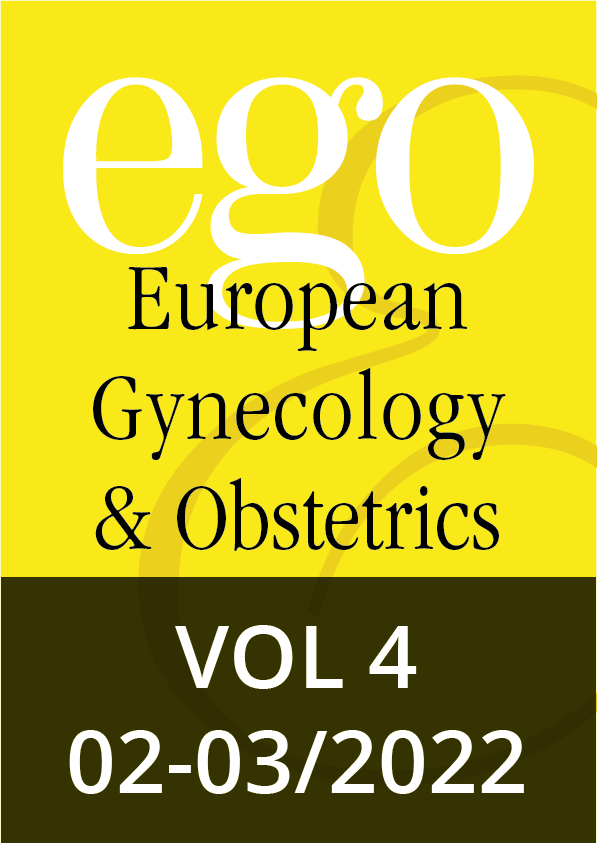Short reviews, 066-070 | DOI: 10.53260/EGO.22402031
Reviews, 071-075 | DOI: 10.53260/EGO.22402032
Case reports, 076-078 | DOI: 10.53260/EGO.22402033
Case reports, 079-081 | DOI: 10.53260/EGO.22402034
Case reports, 082-085 | DOI: 10.53260/EGO.22402035
Original articles, 086-094 | DOI: 10.53260/EGO.22402036
Original articles, 095-0102 | DOI: 10.53260/EGO.22402037
Original articles, 103-105 | DOI: 10.53260/EGO.22402038
Original articles, 106-111 | DOI: 10.53260/EGO.22402039
Original articles, 112-116 | DOI: 10.53260/EGO.224020310
Sonographic tape characteristics and outcome after tape anti-incontinence surgery: a cross-sectional study
Abstract
Background: Ultrasound (US) is an easy-to-perform imaging modality that allows in vivo evaluation of the tension free-vaginal tape obturator (TVT-O).
Aim: To investigate the position and shape of TVT-O using US, in order to correlate the findings to outcome.
Methods: Our cross-sectional study is based on the data obtained from 46 women with stress urinary incontinence (SUI) who underwent TVT-O insertion at a tertiary hospital between January 2015 and December 2016. These patients underwent a postoperative examination in 2020 (5 years after TVT-O). Patients who had undergone reoperation were excluded. The main outcome parameters were patient’s symptoms, US measurements and dynamic changes in TVT-O shape at rest and during straining. A descriptive and comparative (bi- and multivariant) statistical analysis was performed by Stata v14.0.
Results: At five years, 76% (35/46) were continent, 17.4% (8/46) improved and 6.5% (3/46) were failures. The tape was stretched at rest and C-shaped during straining in 27 (58.7%) patients; 92.6% (25/27) of these women were continent after surgery. An unchanged tape shape was associated with a more failures. Patients with a stretched tape at rest and during straining failed in 57.7% and patients with a permanent curved shape in 42.3%. SUI was most accurately predicted using a multiple linear regression model based on the independent variables: age, bladder wall thickness, distance of the tape from the bladder neck and study groups according to Kociszewski criteria.
Conclusions: Outcome was best in women in whom US demonstrated the elastic sling to lie parallel to the urethra at rest and assumed a transient C-shape during straining. However, other US measures could predict patient satisfaction or subjective cure/improvement.
Keywords: stress urinary incontinence, Tension free-vaginal tape obturator, ultrasound.
Citation: Vilar L.,Lleberia J.,Mestre M.,Pubill J.,Burgaya N.,Canet Y., Sonographic tape characteristics and outcome after tape anti-incontinence surgery: a cross-sectional study, EGO European Gynecology and Obstetrics (2023); 2022/02-03:112-116 doi: 10.53260/EGO.224020310
Published: May 22, 2023
ISSUE 2022/02-03

Short reviews, 066-070 | DOI: 10.53260/EGO.22402031
Reviews, 071-075 | DOI: 10.53260/EGO.22402032
Case reports, 076-078 | DOI: 10.53260/EGO.22402033
Case reports, 079-081 | DOI: 10.53260/EGO.22402034
Case reports, 082-085 | DOI: 10.53260/EGO.22402035
Original articles, 086-094 | DOI: 10.53260/EGO.22402036
Original articles, 095-0102 | DOI: 10.53260/EGO.22402037
Original articles, 103-105 | DOI: 10.53260/EGO.22402038
Original articles, 106-111 | DOI: 10.53260/EGO.22402039
Original articles, 112-116 | DOI: 10.53260/EGO.224020310
